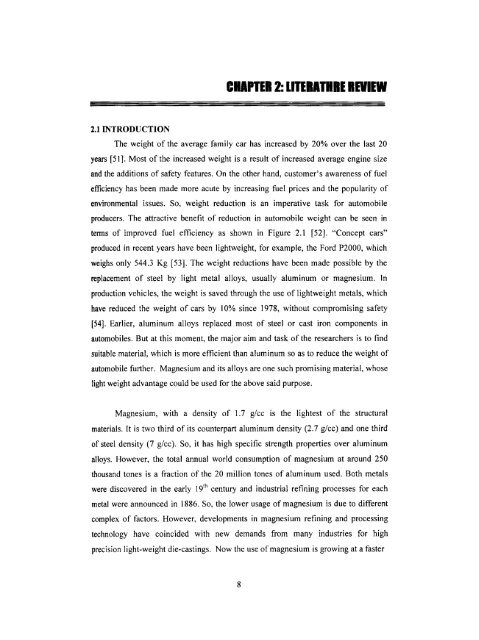“Influence of Si, Sb and Sr Additions on the Microstructure ...
“Influence of Si, Sb and Sr Additions on the Microstructure ...
“Influence of Si, Sb and Sr Additions on the Microstructure ...
You also want an ePaper? Increase the reach of your titles
YUMPU automatically turns print PDFs into web optimized ePapers that Google loves.
2.1 INTRODUCTION<br />
llllll"l'ElI 2: lll'ElllTll|II IIEIIEW<br />
The weight <str<strong>on</strong>g>of</str<strong>on</strong>g> <strong>the</strong> average family car has increased by 20% over <strong>the</strong> last 20<br />
years [51]. Most <str<strong>on</strong>g>of</str<strong>on</strong>g> <strong>the</strong> increased weight is a result <str<strong>on</strong>g>of</str<strong>on</strong>g> increased average engine size<br />
<str<strong>on</strong>g>and</str<strong>on</strong>g> <strong>the</strong> additi<strong>on</strong>s <str<strong>on</strong>g>of</str<strong>on</strong>g> safety features. On <strong>the</strong> o<strong>the</strong>r h<str<strong>on</strong>g>and</str<strong>on</strong>g>, customer’s awareness <str<strong>on</strong>g>of</str<strong>on</strong>g> fuel<br />
efficiency has been made more acute by increasing fuel prices <str<strong>on</strong>g>and</str<strong>on</strong>g> <strong>the</strong> popularity <str<strong>on</strong>g>of</str<strong>on</strong>g><br />
envir<strong>on</strong>mental issues. So, weight reducti<strong>on</strong> is an imperative task for automobile<br />
producers. The attractive benefit <str<strong>on</strong>g>of</str<strong>on</strong>g> reducti<strong>on</strong> in automobile weight can be seen in<br />
temis <str<strong>on</strong>g>of</str<strong>on</strong>g> improved fuel efficiency as shown in Figure 2.1 [52]. “C<strong>on</strong>cept cars”<br />
produced in recent years have been lightweight, for example, <strong>the</strong> Ford P2000, which<br />
weighs <strong>on</strong>ly 544.3 Kg [53]. The weight reducti<strong>on</strong>s have been made possible by <strong>the</strong><br />
replacement <str<strong>on</strong>g>of</str<strong>on</strong>g> steel by light metal alloys, usually aluminum or magnesium. ln<br />
producti<strong>on</strong> vehicles, <strong>the</strong> weight is saved through <strong>the</strong> use <str<strong>on</strong>g>of</str<strong>on</strong>g> lightweight metals, which<br />
have reduced <strong>the</strong> weight <str<strong>on</strong>g>of</str<strong>on</strong>g> cars by 10% since 1978, without compromising safety<br />
[54]. Earlier, aluminum alloys replaced most <str<strong>on</strong>g>of</str<strong>on</strong>g> steel or cast ir<strong>on</strong> comp<strong>on</strong>ents in<br />
automobiles. But at this moment, <strong>the</strong> major aim <str<strong>on</strong>g>and</str<strong>on</strong>g> task <str<strong>on</strong>g>of</str<strong>on</strong>g> <strong>the</strong> researchers is to find<br />
suitable material, which is more efficient than aluminum so as to reduce <strong>the</strong> weight <str<strong>on</strong>g>of</str<strong>on</strong>g><br />
automobile fur<strong>the</strong>r. Magnesium <str<strong>on</strong>g>and</str<strong>on</strong>g> its alloys are <strong>on</strong>e such promising material, whose<br />
lightweight advantage could be used for <strong>the</strong> above said purpose.<br />
Magnesium, with a density <str<strong>on</strong>g>of</str<strong>on</strong>g> 1.7 g/cc is <strong>the</strong> lightest <str<strong>on</strong>g>of</str<strong>on</strong>g> <strong>the</strong> structural<br />
materials. It is two third <str<strong>on</strong>g>of</str<strong>on</strong>g> its counterpart aluminum density (2.7 g/cc) <str<strong>on</strong>g>and</str<strong>on</strong>g> <strong>on</strong>e third<br />
<str<strong>on</strong>g>of</str<strong>on</strong>g> steel density (7 g/cc). So, it has high specific strength properties over aluminum<br />
alloys. However, <strong>the</strong> total annual world c<strong>on</strong>sumpti<strong>on</strong> <str<strong>on</strong>g>of</str<strong>on</strong>g> magnesium at around 250<br />
thous<str<strong>on</strong>g>and</str<strong>on</strong>g> t<strong>on</strong>es is a fracti<strong>on</strong> <str<strong>on</strong>g>of</str<strong>on</strong>g> <strong>the</strong> 20 milli<strong>on</strong> t<strong>on</strong>es <str<strong>on</strong>g>of</str<strong>on</strong>g> aluminum used. Both metals<br />
were discovered in <strong>the</strong> early 19“ century <str<strong>on</strong>g>and</str<strong>on</strong>g> industrial refining processes for each<br />
metal were announced in 1886. So, <strong>the</strong> lower usage <str<strong>on</strong>g>of</str<strong>on</strong>g> magnesium is due to different<br />
complex <str<strong>on</strong>g>of</str<strong>on</strong>g> factors. However, developments in magnesium refining <str<strong>on</strong>g>and</str<strong>on</strong>g> processing<br />
technology have coincided with new dem<str<strong>on</strong>g>and</str<strong>on</strong>g>s from many industries for high<br />
precisi<strong>on</strong> light-weight die-castings. Now <strong>the</strong> use <str<strong>on</strong>g>of</str<strong>on</strong>g> magnesium is growing at a faster<br />
8
















